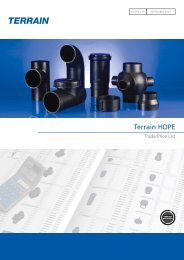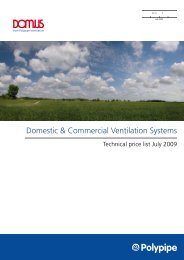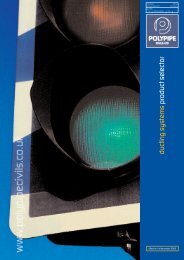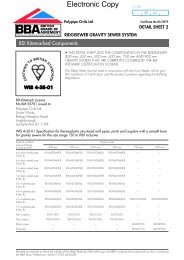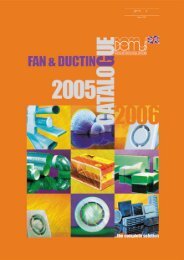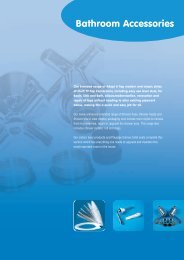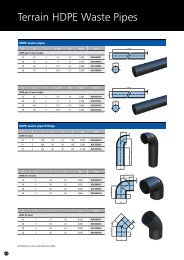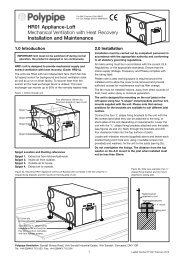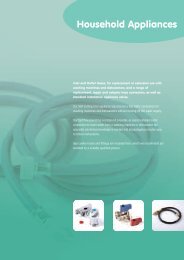Create successful ePaper yourself
Turn your PDF publications into a flip-book with our unique Google optimized e-Paper software.
POLYPLUMB JOINTING, DISMANTLING AND SYSTEM TESTINGDismantling a PolyplumbjointPolyplumb fittings must not bedismantled for any reason priorto jointing.Procedure for using thecomponent pack of sparesDismantling the jointStep 1:If it is necessary to remove a jointedpipe from a fitting, the cap-nut shouldbe unscrewed and the pipe with allthe socket components present on thepipe end should be pulled out of thesocket of the fitting. The pipe endcomplete with all the socketcomponents should be cut off anddiscarded. A complete componentpack of socket spares should be fittedto the socket as described below andpipe jointing should be carried out asdescribed left (see fig.1)Replacement componentsStep 2:The component pack (Code: PB95XX)is supplied as a cap-nut with all thesocket components present in thecorrect order and retained by aretaining cap.Preparing componentsStep 3:Checking the fittingStep 5:Carry out a visual check to ensure thatall socket components are present inthe correct order as shown in thediagram and that the rubber ’O’ring islubricated. If in doubt, the ‘O’ringshould be re-lubricated usingPolyplumb silicone lubricant.Fitting the jointStep 6:Carry out pipe jointing as describedon page 10 from step 3 onwards.Reduced componentfittingsChanges have been made to 15mmPolyplumb couplers, elbows and teesand 22mm Polyplumb elbows andtees, which need to be consideredwhen using Polyplumb spares kitswith these fittings, as follows:Original Polyplumb fittingsStep 1:If the bottom white washer is presentin the fitting below the grab-ring,then the spares kit can be used assupplied without making any changes.New Polyplumb fittingsStep 2:System testingPressure testing of systems isrecommended.1st fix installationsPipe and fittings only should betested. The system should becompletely filled using water at notmore than 20°C at a test pressure of18 Bar which should be applied fornot less than 15 minutes and nolonger than 1 hour.Joint security can be checked visuallyand by tugging at joints.2nd fix installationsComplete installations includingappliances should be tested withwater to the maximum test pressureallowed by manufacturers of theappliancesand fittings.Please note, due to health and safetyreasons <strong>Polypipe</strong> do not recommendair testing of pipework installations.Pressure testing in sub-zerotemperaturesSpecial precautions arenecessary if the pressure testingis to take place in sub-zerotemperatures.This applies particularly in under floorcentral heating systems using thescreeded floor system where most ofthe pipe is encased in concrete. Due toCompletely remove the retaining cap,ensuring that the socket componentsremain within the cap-nut.Replacing the componentsStep 4:Without removing any of the socketcomponents from the cap-nut,introduce the cap-nut and socketcomponents to the socket of thefitting and tighten up the cap-nut byhand ensuring that the componentsenter the socket without snagging.If there is no bottom white washerpresent below the grab-ring with oneof the five listed fittings then this isone of the fittings which has beenmodified.Before the spares kit is used, thecarrier moulding should be carefullyremoved from the cap-nut and thebottom white washer should beremoved and discarded withoutchanging the order of any of theother components. After this has beendone, the spares kit should be offeredup to the socket of the fitting,inserting the components into thesocket in the order they are within thethe contact between pipe and floorpanel on screeded installations, wherethe screed does not completelysurround the pipe, there may bepoints where strain is created on thepipe in freezing conditions which isnot normally present.Therefore it is advisable to drain theunder floor central heating systemonce testing and screeding has beencompleted.Precautions should also be takenwhere installations contain largequantities of fittings which due to therigidity of their construction may putundue pressure on the pipe.kit and then screwing down the capnutonto the outside of the socket(see fig.2).Retaining CapSpacer (28mm only)Grab ring“O” ringRetaining CapSpacerGrab ringPipe StiffenerPipe StiffenerSpacerSpacer Washer“O” ringFig.1: Polplumb fittings general arrangementFig.2: 15mm couplers, elbows and tees and 22mm elbows and teesFor further information refer to Product Guide or www.totallyplumbing.com 07



